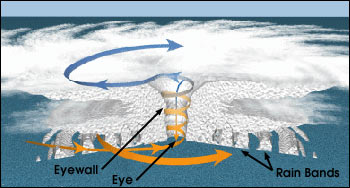HurricanesA hurricane (or typhoon) is a large rotating cyclonic system born in the tropics. They are the largest and most destructive storms on Earth. Most associate high winds with the devastation that these massive storms create, yet dangerous flooding, tornadoes, lightning often accompany or are spawned by a hurricane. Figure 8.32
Hurricane Katrina takes aim at the United States. Hurricane FormationA hurricane develops from a tropical disturbance once it reaches sustained winds in excess of 74 mph (64.3 knots) . Most hurricanes form poleward of 10o latitude as the Coriolis effect is too weak closer to the equator. Hurricanes form in a uniform mass of warm air over tropical oceans with temperatures of 80o F (26.5o C) through a depth of 200 feet (60 meters). Hurricanes thus do not exhibit fronts like extratropical cyclones of the mid- and high latitudes. The "fuel" for a hurricane comes from the enormous amount of latent heat released from the warm ocean water.
A hurricane is a warm-core low pressure system that weakens rapidly with altitude to be replaced by anticyclonic airflow above the hurricane. The center or eye of the hurricane is an area of nearly cloudless skies, subsiding air, and light winds. The eye ranges from 12 to 40 miles across (20 - 65 kilometers). At the periphery of the eye is a ring of cumulonimbus clouds that produce torrential rains and extremely strong winds. Surrounding the core of storms are the typical spiraling rain bands. As a hurricane moves over a colder surface or land, it loses its source of energy and dissipates. However, the system can remain an organized storm for several days as it moves inland, inundating the interior with rainfall causing severe flooding. Destructive tornadoes often accompany hurricanes as the move ashore. Figure 8.34 Video: "Hurricanes" |
 Figure 8.33 Internal structure of a hurricane (Source: NOAA)
Figure 8.33 Internal structure of a hurricane (Source: NOAA)